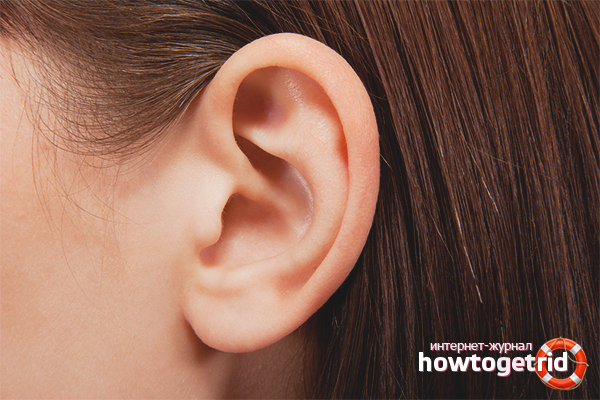The content of the article
Sulfur cork is a problem that is familiar to many people. Some of them do not even realize that hearing loss is associated precisely with the formation of such a cork. It is important to recognize the symptoms of sulfur compaction in time and get rid of it. What is sulfur, how are plugs formed and how can they be removed?
Why does man need sulfur
Sulphurous grease formation is normal. In the cartilaginous (outermost part) of the external auditory meatus (meatus acusticus externus), cerumenous glands are located. They produce a hydrophobic secretion containing a large number of different lipids. Speaking into the lumen of the ear canal, this substance mixes with the secretion of the sebaceous glands and the torn away horny layer of the epithelium. All this becomes sulfur components. Why is it needed?
Between the outer and middle ears is the eardrum, it plays an important role in the process of hearing. However, the membrane itself is a very delicate structure. Any mechanical impact may damage it. Then a person will practically be deaf. Sulfur protects the eardrum, first of all, from water.
During hygienic procedures, water often gets into the ear, but a hydrophobic lubricant prevents it from penetrating the eardrum. This explains why, when diving into the water, the hearing first worsens, then completely recovers.
Cork forming process
Normally, sulfur itself comes out of the ear. When a person chews, sulfur softens and leaves the cavity of meatus acusticus externus. If this does not happen, the lubricant is compacted and hardens, moving deeper into the ear canal. Thus, it can accumulate at the eardrum for a long time.
The first symptoms of the occurrence of sulfuric cork appear very soon. Hearing loss occurs after sulfur completely obstructs the lumen of meatus acusticus externus. In this case, the following manifestations may be present:
- Feeling of stuffy ear;
- Pain inside the ear of varying intensity;
- Unilateral hearing loss;
- When trying to clean the external auditory meatus, a dense dark-colored mass is released;
- Sometimes a noise similar to a squeak, a breath of wind or a pulsation of blood vessels is heard in the ear.
Most often, symptoms occur after water procedures. When water enters the meatus acusticus externus, the sulfur plug swells, becomes too large and blocks the entire external auditory canal. Hearing is reduced and remains at the same level until the plug is removed from the passage cavity.
Causes
As already mentioned, normally sulfur is eliminated from the ear canal independently. Why does it stay inside some people and turn into a cork? There are several reasons:
- Structural features of meatus acusticus externus. In some people, it is too long or too curved, in which case the removal is not complete.
- Excessive sulfur production. There are people whose cerumenous glands work harder than others. A person himself may not know about this, but due to an excess of sulfur, its residual volume after removal is increased. This leads to the formation of traffic jams.
- Hair in the ears. This problem is familiar to men, because it is transmitted exclusively linked to the male sex chromosome. The hairline prevents the removal of sulfur, especially if there is a lot of hair and they are long.
- Cleaning your ears with cotton buds. Many people do not know that mechanical cleaning of the external auditory canal does more harm than good.The fact is that in this way sulfur is, as it were, rammed deeper into the ear canal. Part of it, of course, is extracted, but the lion's share remains inside. Each ear cleaning is a stuffing of sulfur and the formation of cork.
- Wearing a hearing aid. Hard of hearing people know that from the side where they wear the device, traffic jams occur more often than from the opposite. In this case, the hearing aid is simply an obstacle to the natural cleansing of the ear. The problem is that a person already hears weakly and may simply not notice how an obstacle formed on the path of sound waves penetration.
- Listening to music with in-ear headphones. In this case, they act like a hearing aid, being an obstacle to the release of sulfur from the ear. The difference is that the headphones are simultaneously in both ear canals and can help to reduce normal hearing on both sides.
- Temperature and humidity differences. Climate change in the environment can also contribute to the drying or swelling of sulfur in the ear canal.
- Production hazards. Dusty working conditions are especially dangerous: bakeries with flour dust, a construction site with sand or cement chips, mines with coal dust. Small particles settle in the ear canal, changing the physicochemical properties of sulfur, which now becomes denser and worse subject to purification.
- Elderly age. Over the years, the properties of sulfur change, it becomes less organic compounds and more inorganics. Such a lubricant is harder, denser, it does not fulfill its functions and dissolves very poorly.
Treatment
For any symptoms of the appearance of this pathology, it is recommended to immediately consult an otorhinolaryngologist. The fact is that in the same way a whole series of diseases with a more formidable prognosis can manifest itself. The doctor will not only establish the correct diagnosis, but also cleanse meatus acusticus externus from the sulfur plug.
You can try to get rid of this problem at home. As you know, cotton buds in this case are not the best assistant. So how to remove the sulfur plug? You can just dissolve it. There are substances called cerumenolytic. They help soften, dissolve and drain the components of the sulfuric cork. Cerumenolytic drugs include:
- Drops based on sea water - Aqua Maris Oto;
- Anti-inflammatory drops - Otinum;
- Glycerol;
- Drops of Zerumex;
- Surfactants and surfactants;
- Almond, olive or castor oil;
- Sodium bicarbonate.
In all cases, the method of application is the same: the product is poured into the ear with a syringe without a needle (drops can be used from the bottle). You should lie down with a sick ear up for at least 15 minutes. Then flush the ear with water or peroxide (if oils were used) from the syringe.
The procedure is repeated daily until the cork is dissolved.
What will the hospital do to remove the cork
The doctor has a greater arsenal of funds than a home first aid kit. Perhaps it will be limited to the use of cerumenolytic agents. However, sometimes this is not enough. A tight, dense or too large plug is thus almost impossible to remove. In this case, you can resort to the following methods:
- Aspiration. It is used by otorhinolaryngologists in the formation of a plastic plug, which is poorly soluble. The nozzle of a special electric suction pump is inserted into the ear and sulfuric masses are extracted. The procedure is painless, but not all plugs can be removed in this way.
- Curettage. A special medical instrument - an ear probe - is inserted into the ear through a funnel, which increases the field of view. The procedure is quite dangerous, but effective for the accumulation of solid masses. After curettage, the cavity of the external auditory meatus is disinfected.
Prevention
The sulfur removal method is the same as the sulfur cork softening method. You just need to choose a suitable cerumenolytic agent and bury it three times a month in the external auditory meatus of both ears.
Thus, we can conclude that sulfur is a natural defense of meatus acusticus externus. Sometimes, due to various reasons, traffic jams form from it that interfere with normal hearing. You can get rid of them by contacting an otorhinolaryngologist or at home, by washing with cerumenolytic agents. To prevent the formation of sulfur plugs, you can use the same drugs as for their treatment.
Video: how to remove sulfur plug from the ear










Submit